Catfish corridors are tireless workers of the aquarium. They perfectly eat up the remains of the food at the bottom, keeping it clean. And even if the color of many species is not particularly bright, their peaceful disposition and interesting behavior make them one of the most popular aquarium fish. In our article, we will talk about the corridor, which resembles a bamboo bear in color, therefore it is called that – panda catfish.
General information
Corridors panda (Corydoras panda) is a freshwater fish from the Armored catfish family. A relatively new species in the aquarium hobby, the first scientific description was compiled only in 1986.
The catfish lives in South America. The fish got its name for its black and white color, reminiscent of the color of a giant panda.
Like other corridors, the fish prefers the lower layers of the aquarium. In addition to gill respiration, the panda catfish also has intestinal respiration. You can see how the fish periodically float up to take a “breath” of atmospheric air. Therefore, it is important that the fish always have access to the water surface.
Appearance
The corridor panda has a dense body, slightly compressed at the sides, rising in front. On the sides of the body are two rows of bone plates, creating a dense shell that protects the fish from enemies. Lower mouth. Near the mouth opening, there are three pairs of sensitive antennae, with the help of which the fish dig in the ground and orient themselves in the muddy water.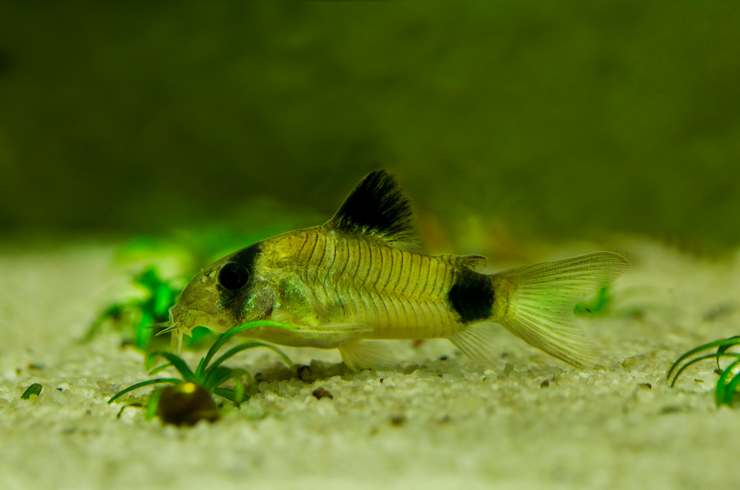
The size of the fish in the aquarium reaches 5-6 cm. The main body color is light or with a pinkish tinge. The panda’s corridor has three black spots: one passes through the eyes, the second is located on the dorsal fin, and the third is near the tail. The rest of the fins are transparent. Gender dimorphism is not expressed.
Habitat
In nature, the panda corridor is found in the upper reaches of the Amazon, or rather in the Ucayali River (Peru), which flows at the foot of the Andes. The water here is sour and soft, the soil is of fine gravel or sand. The rivers are fed by snow melting in the mountains, so the water temperature can drop to 16-18 ° C, in this regard, even in aquariums, catfish calmly tolerate gradual decreases in temperature.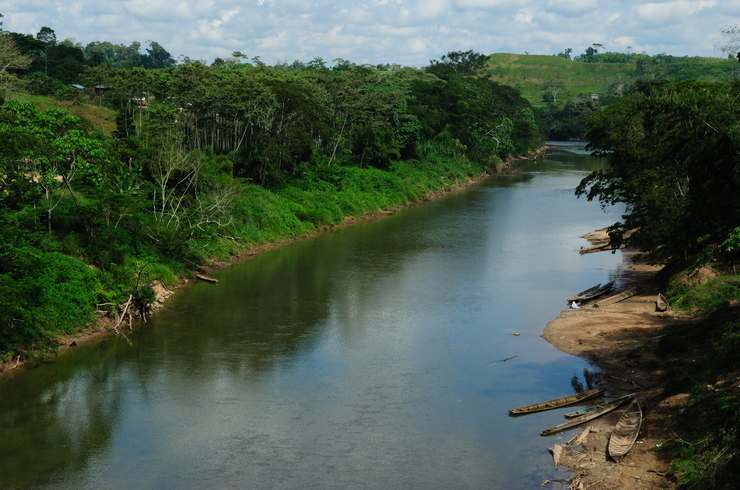
Care and maintenance
Corridors panda – schooling fish, it is necessary to keep at least 5-6 individuals. Given the small size of the fish, the minimum volume of the aquarium starts at 40 liters. Quartz sand or small rounded pebbles are perfect as soil. Try to avoid pebbles with sharp edges, corridors about them can injure their sensitive antennae.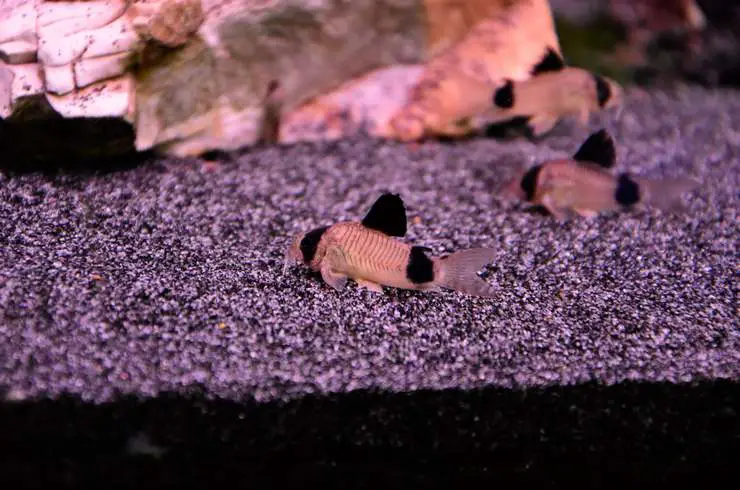
A large number of shelters should be created in the aquarium, where the catfish will hide if necessary. They can be made from driftwood, stones, grottoes, ceramic pots. Aquarium plants should be planted along the walls. Species with large leaves (echinoderms, anubias, cryptocorynes, nymphaea) are especially suitable, creating dark areas at the bottom of the aquarium.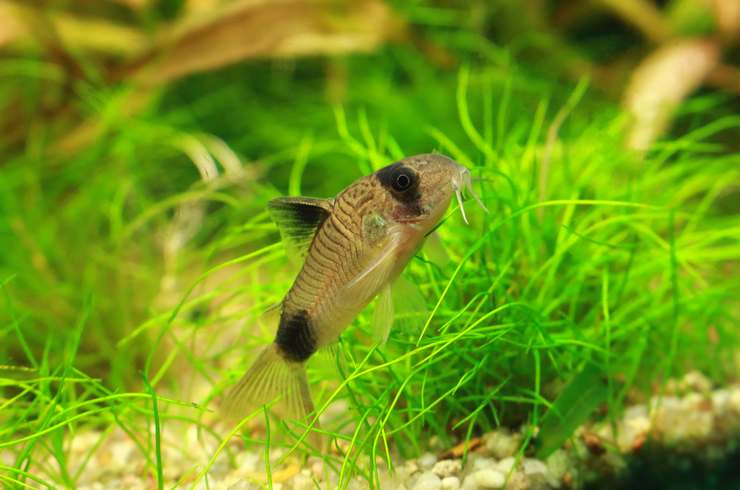
For a comfortable existence, good filtration (but not a strong current) and aeration are required. You can do without a thermostat when keeping fish if the water temperature does not fall below 22 ° C. The lighting should be dim.
Once a week it is necessary to replace up to 20% of the water in the aquarium with fresh water.
Compatibility
Catfish panda gets along well with most types of aquarium fish. Exceptions are, perhaps, large predatory cichlids, which can feast on small catfish. Sometimes there are problems with active barbs (for example, Sumatran barbs), which bite fins along the corridors.
Ideal neighbors will be other types of corridors, tetras, rasbora, Cecilia, zebrafish.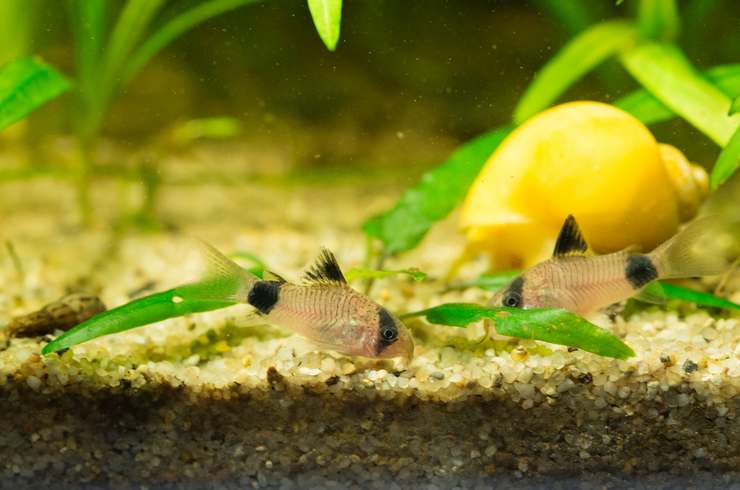
Feeding the corridor panda
Panda corridors are unpretentious in food. The best option for feeding these catfish will be special tablets for bottom fish, which quickly sink to the bottom. Live and frozen food are not recommended as it is not balanced and can become a source of infection in the aquarium.
Considering the popularity of corridor catfish, Tetra has released a special food for them – Tetra Cory ShrimpWafers. The unique two-color wafers fully satisfy the nutritional needs of any shell catfish, and the high shrimp content increases the palatability of the feed and promotes healthy growth.
Perfect for panda catfish and other food for bottom fish – Tetra Tablets TabiMin, Tetra Wafer Mix. These highly nutritious foods contain everything needed for the proper growth and development of catfish, provide resistance to disease and longevity. The special form of tablets, when lowered to the bottom, retains its shape for a long time, remaining accessible to fish.
Panda corridors are predominantly crepuscular animals, so it’s best to feed them before turning off the lights.
Reproduction and breeding
Breeding panda catfish, although not a very simple process, is quite feasible at home. Spawning is group, usually 1 female and 3-5 males are used. To distinguish a female from a male, you need to look at the fish from above. Pubertal females are larger and wider than males.
For spawning, you need an aquarium of 30 liters or more. Small-leaved plants are laid at the bottom, as well as flat objects – stones, driftwood. Light filtration, aeration, and daily water changes are required (up to 30%). Producers are placed in an aquarium; spawning is stimulated by lowering the water temperature by 2-3 ° C. Spawning begins the next morning. In the course of mating games, males chase the female, after which she picks up the males’ milk in her mouth and lubricates the substrate with them, where she sticks the eggs. This increases the chances of fertilizing eggs. The fecundity of the female is about 70 eggs.
After the process is complete, the producers are removed from the aquarium and antifungal agents are added to the water. Dead white eggs must be removed regularly.
Incubation takes 6-10 days, fry begins to feed on their own one day after hatching. Panda catfish become pubertal at the age of 8-10 months.

